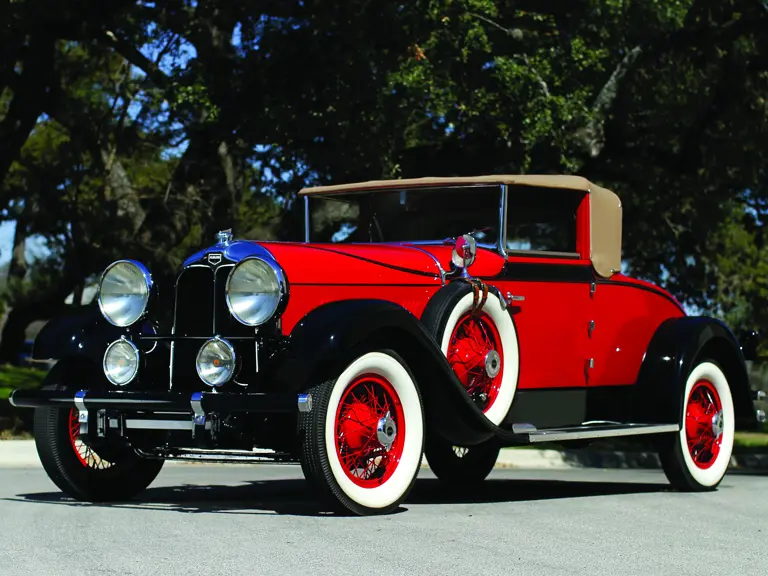
1929 Auburn 8-90 Cabriolet
{{lr.item.text}}
$71,500 USD | Sold
{{bidding.lot.reserveStatusFormatted}}
- 246.6-cid, 93-hp inline eight-cylinder engine
- Three-speed manual transmission
- Very nicely restored example
- Reported that only 150 8-90 Cabriolets built
- Runs and drives effortlessly
- Welcomed by many clubs & groups
- Many desirable period features
- Rumbleseat
The Auburn marque began as the Eckhart Carriage Company, which was established in 1874 by Charles Eckhart in Auburn, Indiana. His sons Frank and Morris built their first solid-tired, tiller-steered runabout in 1900, and organized the Auburn Automobile Company to build it. Twin-cylinder models were available in 1905, a four in 1909 and a six by 1912. Success was modest at best, and the Eckharts sold out to a group of Chicago investors that included chewing gum magnate William Wrigley, Jr., in 1919.
The new management introduced the Auburn Beauty Six that year, a restyled and more attractive automobile, but the post-World War I recession hindered its sales. Large inventories of unsold cars greeted E.L. Cord when he signed on as general manager in 1923. Cord had the stockpiled Auburns repainted in attractive, bright colors and cleared out the inventory in short order. He also bought some eight-cylinder engines from Lycoming Manufacturing Company and for 1925 introduced the Auburn 8-63 and 8-88 with prices starting at $1,895 – quite a bargain for an eight-cylinder car. A dashing and glamorous boattail speedster version introduced in 1928 was a big hit, and total Auburn sales doubled to over 23,000 units for 1929.
In 1926, Cord had purchased Duesenberg Corporation, famous for its racing cars, and used it as the launching platform for a line of high-priced luxury vehicles. Auburn cultivated a strong performance image. At the wheel of an Auburn Speedster, driver Wade Morton clocked 108.46-mph on a measured mile at Daytona Beach and later covered 2,033 miles in 24 hours for a record 84.7-mph average speed at Atlantic City. Morton also set a new record at the challenging Pike’s Peak hillclimb. While competing cars, such as the Stutz, cost nearly $5,000, the Auburn was available for just over $2,000. This enormous value contributed to Auburn’s record sales levels for 1929, and helped Auburn meet the challenges of the looming Great Depression.
Now that he had successfully launched his mighty Duesenberg Model J, and the Cord L-29 was introduced; E.L. Cord gathered together all of his various companies in June under the umbrella of the Cord Corporation. In January, 1929, had acquired one of them, Central Manufacturing in Connersville, Indiana, to increase production capabilities. Cord facilities now made up over 1.5 million square feet of factory floor space, a 900 foot long assembly line, 20 modern buildings with a total capacity of 400 bodies and 250 finished cars per day.
All of this was needed as Auburn dealers couldn’t get their hands on the cars fast enough; stock on hand is reported to have been an average of 1.5 cars per showroom. In the month of May 1929, Auburn is said to have built nearly twice the number of cars as the annual output for all of 1924. In five short years, Cord had increased Auburn’s business by an unbelievable 1,300-percent. The 1929 net profit for Auburn would be an impressive $3.6 million.
The Auburn Cabriolet cost approximately $1,495 in 1929, and it was conveyed as being a “sports car that attracts immediate attention.” Trade advertising of the period proudly heralded that “Auburn offers dealers a complete line of cars, each of which packs a sales wallop that is a complete knock-out for the competition.”
The car offered here, a 1929 Auburn 8-90 Cabriolet on a 125-inch wheelbase, is still a knock-out. It is a beautifully restored example that looks fantastic in red and black exterior tones with a tan interior and soft-top. The car runs with a Lycoming straight eight-cylinder engine that measures 246.6-cid and puts out 93-hp through its driveline with a three-speed manual transmission. It starts easily and the driving characteristics are equally appealing. Chromed trim elements are used lavishly, as when new, giving the Auburn even more “snap.” Attractive pinstripes are in keeping with the distinctive molding sweep over the hood; red wire wheels and whitewall tires are most appropriate, all adding to the undisputed allure of the presentation.
The interior features a padded dash and saddle leather upholstery. The rumbleseat is trimmed to match and period accessories include dual side-mounted spare tires with pedestal mirrors attached, Trippe “Speedlights,” Auburn running board step plates, dual cowllights, trunk rack, Stewart-Warner instrument cluster, “golf club” door, plus the convenience and security of the Cabriolet’s roll-up windows.
The Auburn is welcomed at national events with such esteemed groups as the Auburn-Cord-Duesenberg Club, Classic Car Club of America and Antique Automobile Club of America. With or without club participation; this will be an easy car to enjoy. Resources indicate that in 1929 Auburn built a total of 23,509 cars and 17,853 were registered. Of those, only 150 are reported to have been built in the guise of the desirable 8-90 Cabriolet. This is a machine that will meet many personal requirements and offers the potential of investment – a standard that Auburn has been known for since this car was first built.


 | Auburn, Indiana
| Auburn, Indiana


